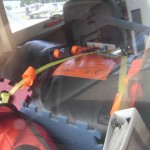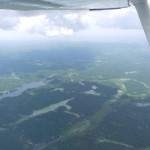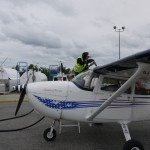The next morning Dave surprised me with his finished wooden construction to keep the tank in place. I studied the performance graphs a few times again, and was a little worried about the forecasted 28°C outside temperature and the airport elevation (about 1000 ft).
It was still morning, and very cloudy. Because of this, the temperature was not yet too high, and it was an ideal situation to make a quick Circuit and check the performance of the plane. I started to taxi with the full ferry tank, but no luggage. It was time for the run up now. Following the checklist as a crazy man, not to forget anything –after all, this would be my last stop with a decent mechanic in the neighborhood- I was a bit too enthusiastic and inadvertently switched off both magneto’s at run up power. A loud bang and red cheeks were the consequence of that.
The rest of the run-up, the plane behaved normally, and I had no problem controlling it. Because of the low clouds, I filed a Special VFR flight plan for one circuit. Another one of my firsts ! Applying power, I started the take off roll. The airspeed indicator slowly came alive, and t he controls were still responding nicely. No problem with a center of gravity close to the aft limit. I slowly rotated the plane and got a decent 500 feet per minute climb out of it to circuit altitude. Staying below the clouds was not too hard, and the sun started to break through them. Everything was looking perfect for the trip this day. I turned final and started to slow down, again paying special attention to the COG. The elevator trim was still within limits, again putting my mind at ease. I made a smooth landing, and taxied back to the mechanic.
I asked him if my little magneto bump (which they all heard) would cause any trouble, and was assured that as long as I wouldn’t do it every time, there would be no problem. I spent the next hour stuffing all my stuff in the plane. Although it were a lot of small bags, collecting them all took a while, and I had the vague idea they would be heavier than expected. I also loaded the survival equipment: arctic tent, sleeping bag, gun with ammunition, life raft for one person and a bright red immersion suit. The plane was ready to go, and it was time for a group picture. If everything would go well, I would be back in about two weeks.
The plan was to fly to Nakina (CYQN), about 450 NM from Muskoka. With an average fuel flow of 8 GPH (about 45 USG on board connected to the engine) and a planned groundspeed of 100 kts, this would not be a problem. I said goodbye to Dave and his crew, and started the engine. This time, the airplane behave a little bit more vividly, which made me think the COG has shifted a little bit more to the back, but should still be within limits. This time runway 36 was in use, which meant I had to taxi a little bit on the runway, and then leave it again to ask permission to enter the runway for take-off. Basically, taxiing was uncontrolled, but take-off was a controlled action. Which makes you wonder what would happen if an airplane cleared for take-off would meet a legally taxiing uncontrolled airplane during his take-off roll…
Taxiing very slowly and trying to avoid as many bumps as possible, I made it to the threshold. A few minutes later, I got my IFR clearance. The weather had cleared up a lot already, but there were some isolated low level clouds that I wanted to cross. The temperature had climbed from about 22°C to 28°C. As I did two hours ago, I lined up on the runway (albeit in the other direction). The runway was clear and take-off power was applied. The engine veered to live and it took the airspeed indicator just a little longer to come to life. I took the stick back and became airborne slowly. Very slowly. The indicated rate of climb was about 200 feet per minute. I slowly cleared the trees at the end of the runway and was flying over the forest. Not being very comfortable with this rate of climb, I remembered my ATPL courses and realized that I had to lose the flaps to get a better rate of climb. So that’s exactly what I did. Only problem, even though I was flying for a few minutes, I only made it to 400 ft AGL. Retracting the flaps required me to put the nose down to keep up the speed and to avoid a stall. Not a very smart move at that time if you look back on it. The trees suddenly started to grow again. I lost 100 ft before I got enough speed to risk climbing again. After 15 minutes I made it to 4000 ft and informed ATC I would not be going any higher (I filed 7000 ft). I even had to fly full throttle to keep this altitude.
Since this take-off, I decided to manually switch the fuel tanks every half an hour, to keep better track of my fuel consumption. It soon turned out I would probably not make it to my destination due to the hot weather, low altitude and a 15kt headwind. The fuel consumption was also a lot higher (I calculated it had been 10 – 11 GPH after the flight). The EET for Nakina kept going down, and for a moment I thought I would make it. I made the last switch of the tank 30 minutes before I estimated the tank would go dry. I kept looking for alternative airports in the vicinity, while continuing to Nakina. After 35 minutes of flying on the tank, the indicator indicated the tank was completely empty. Because I wanted to know the accuracy of the indicater, I kept flying on the tank, holding my hand on the fuel tank switch. Every little vibration made my heart skip a beat, only to see that nothing happened and it was probably just a little bit of wind. I watched the GPS screen.
“1h15 to go… If the tank would be empty now, I wouldn’t be able to make it.” “1h to go… If it would be empty now I might make it, the other tank should be a little bit fuller, or not ?”… “50 minutes to go, if it keeps going like this I’ll make it…” “45 minutes to go, hmm, border case, I’ll probably make it, but what if the airport would have a problem or a closed runway and …” . Suddenly there was a sputtering engine and silence. Even though it was expecting it, an engine failure does surprise you and it took a few moments to realize that this time it was no wind and the engine did indeed quit. I turned the fuel tank switch and was happy to see the engine come to life again within seconds. A lot less than the 30 seconds Cessna documented in their manual. I checked my watch and noticed I had at least 50 minutes of fuel left. Time to check the options: would I make Nakina? Probably yes, especially if you include the descend which would make the fuel consumption even less than the previous 50 minutes. It was only a 40 minute flight at this point. The closest airport which looked like a descend place was Manitouwadge (CYMG). I didn’t want to end my adventure running out of fuel due to a fuel calculation, so I decided to divert to Manitouwadge, which was only 10 minutes flying away.
I tried to inform ATC of my diversion, but I was in an area not covered by any control frequency. They were not expecting me for another 50 minutes anyway, so I diverted quietly. I tried calling Manitouwadge (I just love writing this name, Manitouwadge! ) but received no response. Flying overhead I noticed the wind sock, and proceeded to my best choice of runway for the final approach.
Now, when I looked into the manual of the Cessna, emptying the main tanks would cause the COG to move a little bit forward. I was thus expecting no problems for landing. On final however, I noticed I needed full forward trim and still had to push the elevator forward a bit. Not wanting to stall or spin in these conditions, I made a fast approach, floated over half the runway, and made a smooth landing in Manitouwadge. The airport was totally isolated. Completely dead. I had a sparkle of hope when I tried the door of the airport building and it was open, only to found the second door locked. The first door gave me access to the phone so I could close my flight plan. The friendly Canadian lady at the other end of the line didn’t even know where Manitouwadge was located, which gave already a little hint of my situation. There were some signs on the wall for fuel services, all jet fuel. Time for my plan B: crack open the ferry tank and start pumping some fuel in the main tanks.
I installed the pumps and tubes, sticking everything together with duct tape. At that moment, a dark cloud was floating by over the airport. It was then, all by myself on that airport, messing around with the airplane, in the chilly weather (the temperature had dropped to +- 16°C and I was still in full summer clothes), that I first felt lonely. I was only at 49°N (even more south than Belgium), and I started to wonder what I’d gotten myself into. What if the plane broke down here ? What if the tank started to leak ? What if I would get robbed ? All questions I had answered to myself before the trip, but the answers didn’t sound too convincing at this time. Not having a lot of options, I continued on my task at hand so I could make it to Nakina. They were expecting me there, and assured me they had plenty of fuel and were open all day.
My optimism soon returned when I first switched on the fuel pumps, and I noticed the fuel gauge going up very slowly. I tested it for a minute, and then decided to start the engine to avoid an empty battery. I was sitting there in the airplane, standing stationary, running the engine and burning fuel, just to put more fuel in the tanks. The irony made me smile, and at that time the sun evaporated the dark cloud over the airport. My optimism was back and I was going to the North Pole. Yay !
I taxied and took off, all in one fluent motion and had Nakina in sight half an hour later. It started to become cloudier every moment, and I made a landing in the grey airport. I was worrying this would be a second Manitouwadge scenario, but then I saw a local guy popping up in the door, asking me what I needed. I told him I needed a full tank of AVGAS. When he asked me where the fuel caps were, I realized that even here, only a few hours flying away from the US border, a Cessna 172 was already considered a peculiarity. I told him they were on top of the plane. With a friendly smile he started to fuel it. My first idea was to camp at the airport to save some dollars (which wasn’t a problem according to his colleague I spoke to the day before on the phone), but when he told me he chased away bears this week and there was a motel just next to the airport, it was an easy choice. It wasn’t even expensive, a little unexpected in an isolated village as Nakina.
The temperature had gone down even more, and it was time to switch to my autumn clothes. The lady owner of the motel gave me directions to the only restaurant in town. While walking (it’s not far, but then again, nothing is far in Nakina) I passed the friendly airport employee who was just finishing his shift. He offered me a ride to the restaurant. I was not even seated yet before he friendly but firmly ordered me to buckle up. Which I did. Of course. I learned he was born in Nakina and adopted a few local children. Two minutes later we were in front of the restaurant.
After the good meal (where they thought I was French, what an insult to my Flemish heritage!), I walked back to the motel in the slight rain. I enjoyed the scenery and the isolated area. Being the last village connected to the road network does mean one doesn’t get a lot of passing traffic.
Back in the motel, I went to bed early, to process everything that happened that day. I slept well.
- Say hello to my little friend
- Ferry tank
- To Nakina/Manitouwadge
- Friendly local airport employee in Nakina



